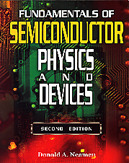相關主題
商品描述
The diminishing size and greater complexity of modern semiconductor integrated circuits poses new challenges in fault detection. Photon Emission Microscopy (PEM) is a physical fault localisation technique used for analysing IC failures. Detailing the PEM technique and its application to semiconductor device analysis, this unique reference:
- Illustrates the application of the PEM technique in various areas of device reliability, in particular hot-carrier, oxide and ESD reliability.
- Presents the principles of design and calibration for a spectroscopic emission microscope system along with coverage of the three main operation modes: frontside, backside and spectroscopic PEM
- Provides an analysis of light emission in semiconductors under hot-carrier and high-field impulse stressing in MOS transistors and photon emission from biased MOS capacitors.
Not only an essential reference for researchers and students in the field, the numerous practical examples throughout the text also make this an indispensible guide for failure analysis engineers and microelectrics industry professionals.
Table of Contents
Preface.
Introduction.
Theory of Light Emission in Semiconductors.
Instrumentation Aspects of the Photon Emission Microscope.
Backside Photon Emission Microscopy.
Spectroscopic Photon Emission Microscopy.
Photon Emission from Metal-Oxide-Semiconductor Field-Effect Transistors under Hot-Carrier Stressing.
Photon Emission from Metal-Oxide-Semiconductor Field-Effect Transistors under High-Field Impulse Stressing.
Oxide Degradation and Photon Emission from Metal-Oxide Semiconductor Capacitor Structures.
Index.
商品描述(中文翻譯)
現代半導體集成電路的尺寸縮小和複雜性增加對故障檢測提出了新的挑戰。光子發射顯微鏡(Photon Emission Microscopy, PEM)是一種用於分析集成電路故障的物理故障定位技術。本書詳細介紹了PEM技術及其在半導體器件分析中的應用,這本獨特的參考書籍:
- 說明了PEM技術在各種器件可靠性領域的應用,特別是熱載流子、氧化物和靜電放電(ESD)可靠性。
- 介紹了光譜發射顯微鏡系統的設計和校準原則,並涵蓋了三種主要操作模式:前側、背側和光譜PEM。
- 提供了在熱載流子和高場脈衝應力下,MOS晶體管中半導體的光發射分析,以及偏壓MOS電容器的光子發射。
這不僅是該領域研究人員和學生的重要參考書籍,書中眾多的實用範例也使其成為故障分析工程師和微電子行業專業人士不可或缺的指南。
目錄
前言。
介紹。
半導體中的光發射理論。
光子發射顯微鏡的儀器方面。
背側光子發射顯微鏡。
光譜光子發射顯微鏡。
在熱載流子應力下金屬氧化物半導體場效應晶體管的光子發射。
在高場脈衝應力下金屬氧化物半導體場效應晶體管的光子發射。
金屬氧化物半導體電容結構的氧化物退化和光子發射。
索引。











